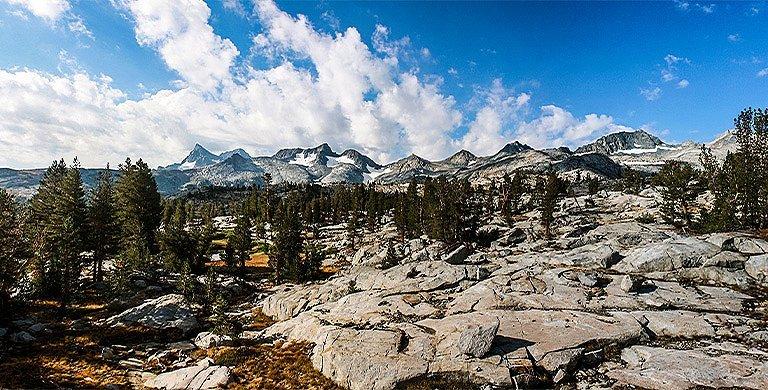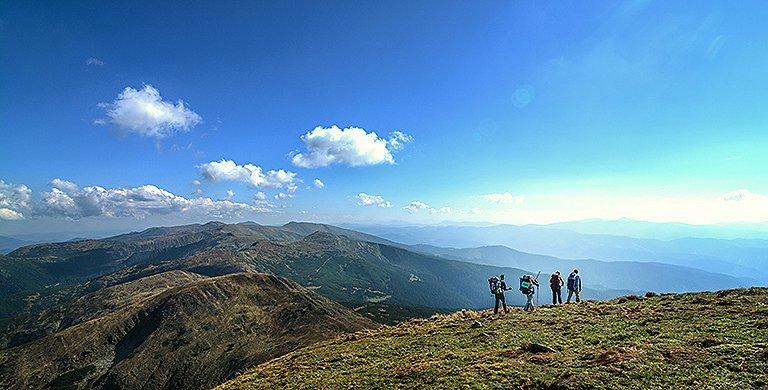HIKING
Columbia Sportswear’s Guide to Hiking the Appalachian Trail
Explore the “Footpath of the People” on a day hike, section hike, or thru hike.
BY NANCY BOUCHARD
You’re rambling through a grove of ancient hardwoods, and, as the trail traces the bend of a river, it skirts cascades of cool, clean water tumbling into a large, rocky pool. Do you stop for a quick swim to rinse off dust and dirt, or continue along as the path ducks through a parade of yellow poplar? As you amble down the well-beaten path, you get a sense of what is arguably America’s most impressive trail-building feat, the Appalachian Trail (AT).
Stretching more than 2,190 miles, the Appalachian Trail is the world’s longest hiking-only footpath. In the 1930s, Harvard-trained forester Benton MacKaye proposed the trail as a way for city dwellers to connect with nature. Its primary purpose was as a recreational resource for people to hike, camp, and enjoy the outdoors. MacKaye also thought that nature could help people suffering from mental health issues. MacKaye also argued that the AT might offer “opportunities on the land” for Appalachian communities struggling with stagnant economies and an exodus of people to big cities. The Appalachian Trail was patterned on Vermont’s Long Trail, which, built in 1910, is the oldest long-distance trail in the US. Not only is part of the Long Trail incorporated into the AT, but so are many other historic foot and wagon paths that were used by Native American tribes, colonial settlers, Revolutionary and Civil War troops, and early conservationists.
Stretching more than 2,190 miles, the Appalachian Trail is the world’s longest hiking-only footpath. In the 1930s, Harvard-trained forester Benton MacKaye proposed the trail as a way for city dwellers to connect with nature. Its primary purpose was as a recreational resource for people to hike, camp, and enjoy the outdoors. MacKaye also thought that nature could help people suffering from mental health issues. MacKaye also argued that the AT might offer “opportunities on the land” for Appalachian communities struggling with stagnant economies and an exodus of people to big cities. The Appalachian Trail was patterned on Vermont’s Long Trail, which, built in 1910, is the oldest long-distance trail in the US. Not only is part of the Long Trail incorporated into the AT, but so are many other historic foot and wagon paths that were used by Native American tribes, colonial settlers, Revolutionary and Civil War troops, and early conservationists.
Volunteers and private donations built the trail; it still relies on more than 30 local AT clubs, as well as the Appalachian Trail Conservancy and the National Park Service. Fully connected in 1937, the AT stretches from Katahdin in Maine’s Baxter State Park to Springer Mountain in Georgia’s Chattahoochee-Oconee National Forest. It crosses New Hampshire, Vermont, Massachusetts, Connecticut, New York, New Jersey, Pennsylvania, Maryland, West Virginia, Virginia, Tennessee, and North Carolina, winding through 21 wilderness areas, eight national forests, and several state parks. Virginia hosts the longest segment of the AT, with 550 miles stretching through the Blue Ridge Mountains and Shenandoah National Park.
The Appalachian Trail is ideal for day hikes, overnights, longer backpacking trips, and section hikes, where people lace together different stretches of the trail, with the idea of completing all of them over a period of months or years. The granddaddy of them all is the thru hike, which, to be officially recognized, requires a person to cover all 2,190+ miles of the trail in a single calendar year. The length of the AT changes slightly from year to year; some trails are closed for repair or regeneration, and others are added.
An estimated 3 to 4 million people hike on the AT annually. In 2023, more than 1,300 people completed the thru hike, meaning they finished the entire trail in a calendar year. Of those who attempt the thru hike annually, only about a quarter finish. Many more are “section” hikers, meaning they work to complete the hike in sections over multiple years. It’s estimated that more than 20,000 people have thru-hiked the AT since the trail's completion in 1937.
The Appalachian Trail is ideal for day hikes, overnights, longer backpacking trips, and section hikes, where people lace together different stretches of the trail, with the idea of completing all of them over a period of months or years. The granddaddy of them all is the thru hike, which, to be officially recognized, requires a person to cover all 2,190+ miles of the trail in a single calendar year. The length of the AT changes slightly from year to year; some trails are closed for repair or regeneration, and others are added.
An estimated 3 to 4 million people hike on the AT annually. In 2023, more than 1,300 people completed the thru hike, meaning they finished the entire trail in a calendar year. Of those who attempt the thru hike annually, only about a quarter finish. Many more are “section” hikers, meaning they work to complete the hike in sections over multiple years. It’s estimated that more than 20,000 people have thru-hiked the AT since the trail's completion in 1937.
How Long Does It Take to Hike the Appalachian Trail?
The Appalachian Trail consists of hundreds of short trails. You can hike for an hour or two, a full day, or camp and stay in a shelter for a few nights.
The fastest known time (FKT) for a thru-hike of the AT is just over 41 days, averaging about 50 miles per day. Regular hikers travel 10 to 25 miles per day, while thru-hikers typically spend four to seven months on the trail, depending on conditions, fitness, and rest days.
The fastest known time (FKT) for a thru-hike of the AT is just over 41 days, averaging about 50 miles per day. Regular hikers travel 10 to 25 miles per day, while thru-hikers typically spend four to seven months on the trail, depending on conditions, fitness, and rest days.
Can a Beginner Hike the Appalachian Trail?
Yes, anyone can hike the Appalachian Trail. Beginners should start with short day hikes to build up their trail legs. While some terrain is rugged with significant elevation changes, several sections have been modified to accommodate individuals with disabilities. Parts of Bear Mountain State Park (NY), Shenandoah National Park (VA), and Baxter State Park (ME) have accessible trails, making them ideal for beginners or non-hikers who want to experience the trail.
How Many Miles a Day Should You Walk If You Are Attempting an Appalachian Trail Thru-Hike?
Daily mileage depends on how long you plan to be on the trail. Most people take about five months to hike the entire 2,000+ mile length of the AT. Generally, they travel 10 to 12 miles on steep and rugged days, and 20+ miles on flatter days. If you have prior hiking experience and training, you can start with an average of 15 to 20 miles a day. If you lack fitness, start at a slower pace of 5-10 miles a day; you’ll build endurance quickly and can increase your pace as you progress.
How Much Money Do You Need to Hike the Appalachian Trail?
Day hiking along the AT is very budget-friendly, but sectional or thru-hikes involve more expenses. Experts estimate that you should budget $1,000 per month for a thru or section hike. This budget includes permits, food, transportation, equipment, and apparel, as well as expenses in trail towns. With the AT passing through at least 50 trail towns, you can combine trail experiences with some in-town pampering.
Do You Need a Permit to Hike the AT?
In contrast to the Pacific Crest Trail (PCT), where you can get a free thru-hiking permit, there is no single permit for the AT. Most of the trail is free, but you will need to pay when passing through specific areas. For example, in the Great Smoky Mountains National Park in Tennessee, you can buy a $40 thru-hiking permit or pay $8 per night for backcountry permits if you don't meet the criteria of a thru-hiker. In Shenandoah National Park, Virginia, you'll need to pay an entry fee plus purchase a backpacking permit and nightly reservation fees. Some parks, like Baxter State Park in Maine, also have camping fees.
How Does the AT Differ from the PCT?
The AT is unique due to its extensive system of huts, lodges, and shelters along the trail. While camping is allowed in many places, there are over 260 shelters and huts where you can stay. Reservations are often required. Hikers are encouraged to use these shelters to help protect the environment, as tents can disrupt the natural flora and fauna. Many of these lodges are operated by the Appalachian Mountain Club.
What to Wear When Hiking the Appalachian Trail
Your outfit choice will depend on whether you are doing a day hike or attempting something longer. Here are some recommendations for items to keep you comfortable on the trail.
- Footwear: Wear good hiking boots or sturdy shoes with excellent tread. Much of the trail is rocky, so ankle protection is a good idea.
- Socks: Socks should be at least ankle length to provide adequate protection.
- Clothing: Opt for synthetic pants, a lightweight synthetic shirt, a lightweight mid-layer, and a rain jacket.
- Summer Gear: In the summer, you'll deal with rain, humidity, and bugs, so choose apparel that breathes well and provides protection from mosquitoes.
Navigation on the Appalachian Trail
In contrast to the Continental Divide Trail and the PCT, the AT has excellent signage. While you should always bring a map and a compass, the trail is well-traveled and well-marked. If you are carrying a smartphone, FarOut Guides provides resources on where to go, where to camp, how fast you need to walk to meet your goals, maps, and even insights into what to pack. If you want to explore sections of the trail before you go, try the Appalachian Trail Interactive Map provided by the Appalachian Trail Conservancy (ATC). You can also buy excellent maps of the entire trail from the Appalachian Trail Store.
Preparation for the Appalachian Trail
To train for an AT thru hike, start with day hikes. Then get some practice on multi-day backpacking or hut trips. The great thing about the AT is that there are abundant shelters, bunkhouses, cabins, yurts, and lodges where you can stay, so you don’t have to be an expert backpacker to enjoy overnights on the trail. There are some gorgeous sectional hikes that make excellent shorter trips. For example, you can hike sections like the Shenandoah National Park or the Great Smoky Mountains National Park, which offer stunning scenery and manageable distances for beginners.
Trail Safety
Approximately 100 people have died while hiking the AT, mostly due to falls, weather, and medical issues. Hikers need to be aware of the potential for high, fast water in river crossings, lightning strikes, and forest fires. There are also natural hazards such as bears, ticks, and snakes.
Human-caused dangers also exist, as the trail is within a day’s drive of many major U.S. cities and has frequent road crossings. Avoid sharing plans and locations with strangers, both online and in person. Whether you are on a day hike, backpacking trip, section hike, or thru-hike, always leave travel details, such as your destination and estimated time of arrival, with a trusted source.
The Appalachian Trail is a national treasure that anyone can enjoy. It doesn’t matter if you are walking a single mile or committed to record-breaking thru hike, the AT has something to offer everyone. When you are walking along the AT, you are hiking through history; you can camp, fish, birdwatch, learn about geology, and connect with nature and other hikers. Plan a short trip or a long one, you’ll be glad you did.
Human-caused dangers also exist, as the trail is within a day’s drive of many major U.S. cities and has frequent road crossings. Avoid sharing plans and locations with strangers, both online and in person. Whether you are on a day hike, backpacking trip, section hike, or thru-hike, always leave travel details, such as your destination and estimated time of arrival, with a trusted source.
The Appalachian Trail is a national treasure that anyone can enjoy. It doesn’t matter if you are walking a single mile or committed to record-breaking thru hike, the AT has something to offer everyone. When you are walking along the AT, you are hiking through history; you can camp, fish, birdwatch, learn about geology, and connect with nature and other hikers. Plan a short trip or a long one, you’ll be glad you did.
However you are planning to tackle Appalachian Trail, gear up for your adventure with hiking gear from Columbia Sportswear.



